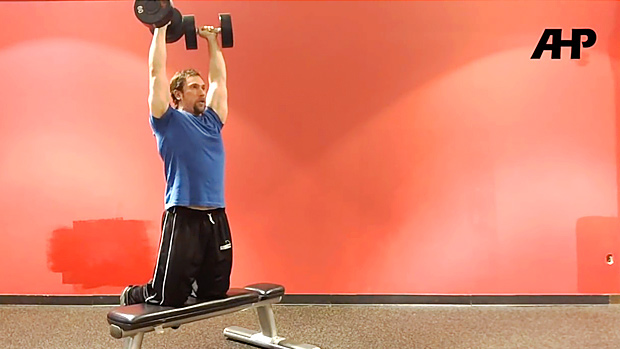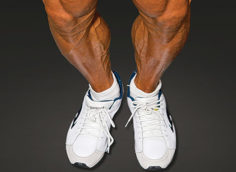Q: I was slumming the other day at a bodybuilding newsgroup, and there was a hot discussion about the validity of ZMA for athletes and bodybuilders. One guy said that ZMA only works if you're very deficient already, and it won't help very much if you're just a regular guy who's training with weights. It sounds like the old boron scam to me. Someone else mentioned that you really like ZMA, so I had to rethink my stance because I really respect your opinion. So help me out here, should I spend my money on ZMA to help maximize T levels?
A: Here's the deal. Depending on the study that you look up, 54-75% of the general American population is deficient in magnesium. Variation for zinc is somewhat greater. Regarding the athletic population, we've found that both zinc and magnesium are deficient in 100% of the athletes who come into our clinic for the first time.
However, I should mention that these people do at least 18 workouts a month. Also, there's a great correlation between their training volume and the extent of the deficiency. In other words, a long-distance speedskater is more likely to be deficient than a track and field sprinter. Triathletes would likely be the ones with the most extensive deficiencies.
When I gave ZMA to my athletes, virtually all of them reported better quality of sleep, an essential factor in maximizing recovery. About 70% of them noted an increase in morning libido. One of them had previous problems conceiving a child, and his low sperm count rebounded after using ZMA for only six weeks.
The magnesium in ZMA is of such high quality compared to the cheap magnesium oxide most commonly found in other products. I was able to reduce the amount of magnesium that I needed to consume in order to avoid further cardiovascular problems by 60%.
In summary, if you live in the US and are fairly active, the odds that ZMA will enhance your performance in the gym are quite high. Expect the results to be the greatest after six weeks of use.
Q: This could get complicated, but what type of training program would you recommend for American football players at high school and college level? Since most football players need size, speed, strength, and agility, it's difficult to choose exercises and rep ranges. Generally speaking, of course, what type of program guidelines would you suggest? Thanks, as always.
A: The answer to your question has been the subject of many books and symposiums. To answer it entirely, though, would require that I move in with you and your family for six months, and it's way beyond the scope on this column. Regardless, here are a few tidbits of my personal philosophy on training the American football player that will whet your appetite for more information.
Depending on the player's position, training would fall somewhere along a speed-strength continuum with sprinters on one end and weightlifters on the other. For example, if you're training a lineman (who's basically paid to take two steps and have a fit), then the training will be more like an Olympic weightlifter, at least in terms of the expression of speed-strength. On the other hand, if you're training a running back, the training would be closer to that of a sprinter.
Most of the repetition schemes used by football players produce nonfunctional hypertrophy (dead weight). If you're going to gain size, it had better be concentrated in the right motor units. An example of a good program for that purpose is outlined in my 1-6 Principle article, which has been very popular with our readers since it produces superior results. The pioneer in this area is Al Vermeil, who questioned traditional training dogma and suggested better training regimens. Incidentally, Al is the only strength coach to sport both Super Bowl and NBA championship rings.
Are most of the devices available for developing agility useful? In the words of Dr. Mauro DiPasquale, do you want the short answer? If so, to again quote Mauro, the answer is bullshit!
In my seminars, I go to great lengths to explain why one of the "pseudo-expert, information broker, never produced any champions, made every client worse" consultants (who we will refer to only by the initials VG) is defrauding athletes and their parents by selling devices that give them basically zero results. One such bullshit device is the speed ladder, which only improves your speed ladder performance. Incidentally, the speed ladder isn't an Olympic nor an NCAA event.
I'll certainly agree that agility is important, as one of the things that makes a great lineman or even a great hockey player is the ability to avoid contact. The Ward brothers were responsible for training the Dallas Cowboys at their zenith, and they instructed players in the martial art Jeet Kune-Do. It's what made a lineman like Randy White possible. He only weighed 258 pounds, yet he tossed around men who outweighed him by over 60 pounds.
In any event, it should be clear that this is a complicated subject. You've got a few choices: read everything that you can on the subject, use trial and error, or attend one of my training seminars.
Q: Hey, a bunch of guys at my gym are using those "Body Blades." Are they worth a wet sack of doggie doody?
A: I know what you're referring to – they're overpriced pieces of plastic with foam handles in the middle. An urban legend states that the guy who patented them stole the idea from a zookeeper who had developed them as "Dynamic Elephant Clitoral Stimulators." He had created them for elephants with low arousal levels during mating season.
They're about as useful as the rolling wooden bars that women sat on to "break down fat," or those high-speed vibrating belts used to "shake off the cellulite" that were popular in 1960s health spas. It's just another case of a piece of junk endorsed by a "pseudo-expert, my son's politically correct because he plays with Barbie, never produced any champions, made every client worse" consultants who's first name sounds like "Bern" when pronounced by Hispanics.
I know quite a few personal trainers who are quite adept at using this device and boast of its terrific capability of building shoulder stabilizers. These guys can also use it on a Swiss ball while whistling Dixie...backward. Amazingly enough, their shoulder stabilization strength hasn't helped break the plateau of benching only 50% of their bodyweight for three reps.
Here's another urban legend for you. Toronto colleague David Harris wanted to try one out last summer at the NSCA convention in Kansas City. Since he'd forgotten to take his epilepsy medication, he went into a grand mal seizure while he tried the Body Blade. To the amazement of Ironman columnist Lorne Goldenberg and me, the convulsions were so strong that the blade remained motionless.
Q: I heard Paul Chek say something about the Total Gym. Isn't that just another piece of infomercial junk? Are any of those "home gym" things worth the money, or should I just buy a bunch of free weights?
A: If you look at older books on conditioning for gymnastics, you'll see earlier models of the Total Gym. In those models, the handles were, in fact, still rings. It allowed a junior gymnast the opportunity to train certain specific gymnastic moves from the rings at a predetermined percentage of his bodyweight. In Hungarian gymnastic programs, you could see those devices lined up on the borders of the training hall.
There are plenty of examples of European devices that were not patented and, subsequently, "American" inventions (the Safety Squat bar comes to mind). Anyhow, the Total Gym is a fairly decent piece of home equipment. By this, I mean that it meets the criteria for selecting home gym equipment:
- It provides overload in both the concentric and eccentric ranges.
- The overload can be gradually increased.
- It can be done for a great variety of exercises.
- It can be stored with minimal space.
- It's safe.
I think that the Total Gym is, in all fairness, a good investment if you have very little space but still want to work out. At some gyms, like Peak Performance in Manhattan, trainers use it with their clients.
Personally, I'd prefer to use dumbbells for a home training device. On the other hand, Tim Patterson prefers to rep out biceps curls using the Charles Atlas Dynamic Tension course, supersetting with Joe Weider's Iron Shoe triceps builders.
Q: Could you settle an argument that I had with my training partner about drop sets? I would just kick my partner's ass, but I married her a few years ago and wish to get laid in the new millennium. When using drop sets on the Scott curl, I say that you should perform about four reps, and then drop the weight. But my wife says to do the usual 8-12 reps to failure, and then lower the weight for another set. If our main goal is size, which method is best? Should we just alternate between the two?
A: The truth of the matter is that you're both right. Each of the methods will work. There are many synonyms for this training technique: down the rack, railroading, suicide sets, etc. Even in the earliest scientific literature on determining the best loading parameters for strength development, drop sets were found to be superior to standard sets for increasing maximal strength. Exhaust the higher threshold fibers first and, as you lower the weight, prolong the time under tension of the worked muscle groups.
The advantage of this method is that even though you may want to go as fast as possible in the concentric contraction, the high tension won't permit you to use high velocities to overcome the load. Therefore, the time under tension will be great, as will the actual load. Depending on your fiber type, your drop set will have a different configuration. Here are some examples:
Mode A – Drop sets for a fast-twitch person
- Perform four rep maximums.
- Drop the weight by 10-15% and perform as many reps as possible (probably one or two).
- Drop the weight by another 10-15% and perform as many reps as possible (probably one or two).
- Rest, then do another two to three drop sets.
Mode B – Drop sets for a fast-twitch person
- Perform two rep maximums.
- Drop the weight by 5-7% and perform as many reps as possible (probably only one).
- Drop the weight by another 5-7% and perform as many reps as possible (probably only one).
- Drop the weight by another 5-7% and perform as many reps as possible (probably only one).
- Rest, then do another three to four drop sets.
Mode C – Drop sets for a normal fiber distribution type
- Perform eight rep maximums.
- Drop the weight by 5-10% and perform as many reps as possible (probably three or four).
- Drop the weight by another 5-10% and perform as many reps as possible (probably three or four).
- Rest, then do another two to three drop sets.
Mode D – Drop sets for a normal fiber distribution type
- Perform six rep maximums.
- Drop the weight by 20% and perform as many reps as possible (probably 12).
- Drop the weight by 20-25% and perform as many reps as possible (probably 25).
- Rest, then do another one to two drop sets.
Keep in mind, too, that machines lend themselves well to drop sets because one can lower the resistance with minimal rest between drops.
Q: You once said in a seminar that you train using low reps, averaging about three reps per set, as I recall. So how come you're so freakin' big? Can you achieve hypertrophy using solely low reps? Does this have to do with your muscle fiber make-up? Are you a mutant?
A: Basically, I only began to grow once I started using very low reps for multiple sets. The key is multiple sets. I'm blessed with a higher percentage than normal of fast-twitch fibers. So, training with high reps is a waste of time for me.
It's my experience that there's an optimal number of sets per muscle group for each individual. Those who are gifted with a large number of fast-twitch motor units always do fewer reps at a given percentage of maximum. While the average trainee performs seven repetitions at 80% of his maximum, a high fast-twitch individual may do only three reps at the same percentage. Conversely, high slow-twitch individuals, who train aerobically, have been shown to do 12-37 RM at 95% of maximum, while average persons will only do two or three RM.
Since there's plenty of empirical evidence and scientific research to point out that the development of maximal strength is best accomplished by using loads representing 70-100% of one's maximum, it appears essential to determine the exact number of repetitions to be performed at this percentage range. For most fast-twitch individuals, the rep bracket optimal for strength gains falls within one to six reps, while most individuals will make gains in the 1-12 rep range. Furthermore, fast-twitch individuals would normally use more sets and short intraset rest intervals (one to three seconds between reps).
An intern of mine, John Alvino, used to get Paul Gagné (one of the best trainers in North America) to write training programs for him. But he wasn't making much progress. After receiving Paul's blessing, John asked me to train him at a Stamford seminar. From initial testing, it became clear that John was doing too many reps. For example, he could only do two reps at 85% of max in the cervical extensors, while world champion speedskater Marc Gagnon could do in excess of 200 reps at 85% of maximum.
Now, John trains by never doing more than six reps, and his yearly average is about 3.5 reps. Well, in 12 weeks, he went from 206 pounds at 11% bodyfat to 218 pounds at 6% bodyfat. He can do close-grip bench presses at more than double his bodyweight, and his curling strength went up 50% during that time. His physique had made such dramatic changes in so short an amount of time that other seminar attendees in NYC (who were also there in Stamford) kept asking him what he'd done differently.
Not to sound immodest, but eight other seminar attendees hired me to write their programs after that.




